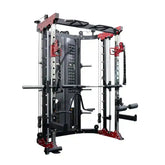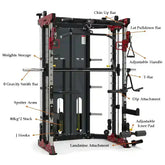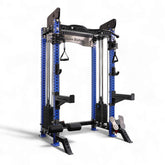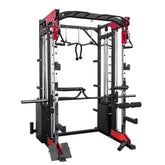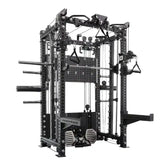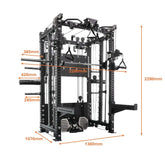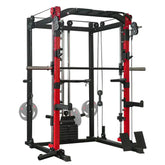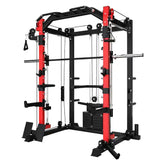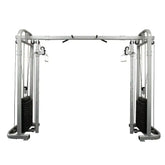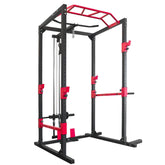The Best Dumbbell Exercises for Total-Body Strength and Definition
These are the most effective dumbbell exercises for building strength, size, and control — ideal for home or gym training with any dumbbell set.
Discover the most effective dumbbell exercises for total-body muscle growth, strength, and definition — train anywhere, anytime.
I’ve spent over ten years training everyone from first-time lifters to competitive bodybuilders — and if there’s one piece of equipment that’s never failed me or my clients, it’s the dumbbell.
When I was competing, I learned that dumbbell exercises aren’t just for isolation — they’re the secret weapon for balance, coordination, and symmetry.
Today, whether I’m coaching professional athletes or everyday clients training at home, dumbbells are always the foundation.
Let’s break down how to use them effectively, which movements deliver the best results, and how to build a complete, efficient physique using nothing more than a set of dumbbells.
Why Dumbbell Exercises Outperform Machines
Unlike fixed-path machines, dumbbells require full-body stabilisation and coordination through every rep. That means you’re not just building muscle — you’re developing real-world strength, balance, and control.

Here’s why I recommend dumbbells to almost every client:
-
Unilateral Strength: Each side of your body works independently, correcting imbalances.
-
Improved Range of Motion: Dumbbells allow natural movement patterns for better muscle activation.
-
Joint-Friendly: The freedom of movement reduces joint strain and enhances long-term training safety.
-
Space-Efficient: With adjustable dumbbells, you can perform hundreds of exercises in even the smallest home gyms.
When used properly, dumbbells turn any room into a performance zone — giving you the freedom to train for size, strength, or endurance on your terms.
Explore the dumbbell collection at Alpha Go Fitness — from adjustable dumbbells for versatility to hex dumbbells for durability.
The Top 10 Dumbbell Exercises for Every Muscle Group
If you’re ready to build strength, power, and shape from head to toe, these are my must-do dumbbell exercises — refined from years of bodybuilding and personal training experience.
1. Dumbbell Bench Press (Chest)
A classic for building chest size and stability while engaging shoulder and tricep support.
How to Perform:
-
Lie on an adjustable bench with a dumbbell in each hand.
-
Press both dumbbells upward until your arms are extended.
-
Lower slowly until your elbows are in line with the bench, maintaining tension throughout.
Prescription: 4 sets × 10 reps
Coach’s Tip: Keep your shoulder blades pinned and avoid bouncing the weights — control builds muscle.
2. Goblet Squat (Legs)
An ideal movement for developing lower-body strength and core stability — no barbell required.
How to Perform:
-
Hold one dumbbell vertically at your chest.
-
Squat until your thighs are parallel to the floor (or slightly below).
-
Drive up through your heels while keeping your chest lifted.
Prescription: 4 sets × 12 reps
Coach’s Tip: Keep your knees tracking over your toes and your heels grounded to maximise power output.
3. Dumbbell Shoulder Press (Shoulders)
Builds strong, sculpted shoulders while engaging your core for stability.
How to Perform:
-
Sit upright on a bench with dumbbells at shoulder height.
-
Press both dumbbells overhead in a controlled motion.
-
Lower them slowly back to shoulder level without locking your elbows.
Prescription: 4 sets × 10 reps
Variation: Perform the movement standing for added core engagement and balance training.
4. Dumbbell Row (Back)
One of my favourite dumbbell exercises for building a thick, wide back.
-
Rest one knee on a bench, dumbbell in the opposite hand.
-
Pull the dumbbell toward your hip while keeping your back straight.
-
4 sets × 12 reps.
Pair this with cable work using a cable machine for maximum back development.
5. Dumbbell Romanian Deadlift (Hamstrings & Glutes)
Builds your posterior chain while strengthening your core and lower back.
-
Hold dumbbells in front of your thighs.
-
Hinge at the hips and lower until you feel tension in your hamstrings.
-
Squeeze your glutes on the way up.
-
4 sets × 8 reps.
6. Dumbbell Lateral Raise (Shoulders)
Shapes and defines the side delts — creating width and symmetry.
-
Raise both arms outward to shoulder height.
-
Control the descent — never drop your arms.
-
3 sets × 15 reps.
Use lighter weights here and focus on perfect form.
7. Dumbbell Hammer Curl (Biceps & Forearms)
A power-builder for the arms, targeting both the biceps and brachialis.
-
Keep palms facing inward.
-
Curl with control and full range of motion.
-
3 sets × 12 reps.
Combine with Progressive Overload Training to increase size over time.
8. Dumbbell Overhead Tricep Extension (Triceps)
Strengthens the long head of the triceps for balanced arm size.
-
Hold one dumbbell with both hands behind your head.
-
Extend upward and lower slowly.
-
3 sets × 10 reps.
9. Dumbbell Reverse Fly (Rear Delts & Back)
Improves posture and shoulder stability while balancing front-to-back strength.
-
Hinge at the hips with a slight bend in the elbows.
-
Raise dumbbells outward and backward.
-
3 sets × 15 reps.
10. Dumbbell Lunge (Legs & Glutes)
Functional, powerful, and perfect for leg balance.
-
Step forward with one leg, lowering your hips until both knees bend at 90°.
-
Push back to the start position.
-
3 sets × 10 reps per leg.
For extra support, train near a squat rack or home gym setup

How to Structure a Dumbbell Workout
If you’re new to strength training or want to maintain balanced muscle development, start with this simple 3-day dumbbell rotation. It targets every major muscle group efficiently — all you need is a home gym dumbbell set and consistent effort.
Day 1 – Push (Chest, Shoulders, Triceps)
-
Dumbbell Bench Press
-
Shoulder Press
-
Tricep Extension
Day 2 – Pull (Back, Biceps, Rear Delts)
-
Dumbbell Row
-
Reverse Fly
-
Hammer Curl
Day 3 – Legs & Core
-
Goblet Squat
-
Dumbbell Lunge
-
Romanian Deadlift
Each session takes around 45–60 minutes and can be done entirely with a single dumbbell set — perfect for a compact home gym.
Nutrition for Dumbbell Training Success
Building muscle, strength, and definition from dumbbell training requires more than just consistent workouts — it demands strategic nutrition.
Here’s what I recommend for sustainable progress:
-
Eat Enough Protein: 1.6–2g per kg of body weight daily to support recovery and muscle repair.
-
Stay Hydrated: Aim for 3 litres of water per day — hydration fuels performance.
-
Prioritise Recovery: Sleep 7–8 hours each night; this is when your muscles rebuild.
-
Use Smart Pre-Workout Meals: Oats, a banana, and black coffee offer steady energy without crashes.
Coach’s Insight: Muscles grow when you recover, not just when you train. Fuel your sessions, rest intentionally, and results will follow.
Common Mistakes to Avoid
Even experienced lifters can sabotage results with small errors. Keep your training safe and effective by avoiding these:
-
Rushing Reps: Control every phase — time under tension builds muscle.
-
Overtraining: 3–4 focused sessions per week are enough for steady gains.
-
Neglecting Legs: Dumbbells are powerful tools for lower-body strength — never skip them.
-
Skipping Warm-Ups: Mobilise shoulders, hips, and ankles before lifting.
-
Ignoring Progression: Track your weights and reps weekly — progressive overload drives growth.
Final Thoughts: One Tool, Endless Possibilities
If there’s one thing I’ve learned as a coach, it’s this:
“The simplest tools deliver the biggest results — when you use them with purpose.”
Dumbbells aren’t just pieces of gym equipment — they’re a lifetime investment in strength, balance, and confidence.
Whether you’re training for size, definition, or overall fitness, mastering dumbbell exercises is one of the fastest, most effective ways to transform your body and mindset.
Start today with the Alpha Go Fitness— turn simple movements into lasting strength.
Frequently Asked Questions
Can I build muscle using dumbbell exercises only?
Yes. Dumbbells offer enough resistance and variety to stimulate full-body muscle growth, especially when paired with progressive overload and proper recovery.
What weight dumbbells should I start with?
Beginners can start with 5–10kg per hand. Intermediate lifters should progress to heavier dumbbells (15–25kg) for strength and size.
Are dumbbells better than machines?
For balance, stability, and natural range of motion, yes. Machines have their place, but dumbbells engage more stabilisers and core muscles, leading to greater functional strength.
Can I do these exercises at home?
Absolutely. With a home gym dumbbell set and an adjustable bench, you can train every major muscle group effectively — no commercial gym required.
How often should I train with dumbbells?
3–4 days per week with rest days between sessions is ideal for muscle growth and recovery. Focus on progression, not perfection — consistency always wins.

